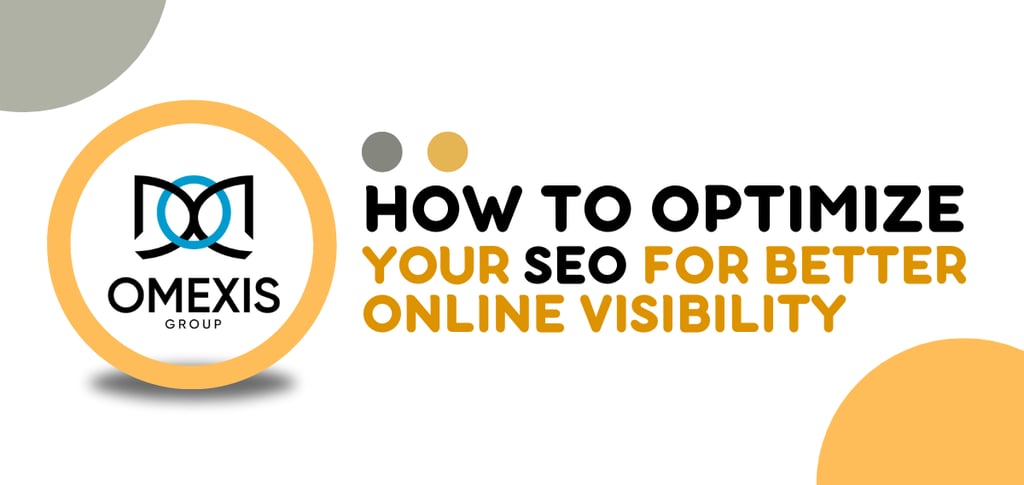How to Optimize Your SEO for Better Online Visibility
Learn simple, effective strategies for content optimizing to improve your website’s SEO and boost online visibility. 🚀 This easy guide covers keyword research, on-page SEO, backlinks, and user experience — everything you need to rank higher on Google and attract more organic traffic. Perfect for beginners, bloggers, and businesses who want real, lasting results.
DIGITAL MARKETING
Asad Ali
10/11/20254 min read


Introduction
If your website isn’t appearing on Google’s first page, you’re not alone. Many business owners, bloggers, and creators face the same problem — their websites exist, but they’re invisible. The solution lies in one simple skill: content optimizing.
In this article, we’ll break down how to optimize your SEO for better online visibility using easy steps anyone can follow — even without being a technical expert. You’ll learn what SEO really means, how Google sees your content, and how to make your website more visible to the right audience.
1. Understand the Basics of SEO
SEO (Search Engine Optimization) means improving your website so search engines like Google can easily understand, rank, and show it to users searching for what you offer.
Good SEO is like putting a bright signboard on a busy street — it helps people find you faster.
The core idea behind SEO and content optimizing is simple:
Write high-quality, relevant content that people are searching for.
Organize it clearly so Google can read and rank it easily.
2. Identify the Right Keywords
Your SEO journey starts with keyword research.
Keywords are the words or phrases people type into Google when looking for information — for example: “best coffee shop in Dubai” or “how to lose weight fast.”
To find the best keywords:
Use free tools like Google Keyword Planner, Ubersuggest, or Ahrefs Keyword Generator.
Look for high search volume and low competition keywords.
Include both short-tail (broad) and long-tail (specific) keywords.
Example:
Instead of targeting “SEO,” target something like “easy SEO tips for beginners.”
Pro Tip – Use your main keyword content optimizing in the title, the first paragraph, subheadings, and once in the conclusion to maintain natural keyword density (around 1%).
3. Optimize Your Website Structure
Search engines love well-structured websites. When your pages are organized, it becomes easier for Google to understand what your site is about.
Here’s how you can improve your structure:
Use clear headings (H1, H2, H3) to organize your content.
Add internal links to connect related articles.
Create a sitemap so search engines can crawl your pages easily.
Use short, clean URLs, e.g., yourwebsite.com/seo-tips instead of yourwebsite.com/page123.
A clean, structured site not only helps with SEO but also gives visitors a better experience.
4. Focus on Quality Content
No matter how advanced SEO becomes, quality content is always king.
Good content optimizing is not about stuffing keywords — it’s about solving your reader’s problems.
To write SEO-friendly content:
Understand your audience’s needs.
Provide practical, clear, and step-by-step solutions.
Use short paragraphs and simple words.
Add examples, images, or short videos to keep readers engaged.
End each section with a helpful takeaway.
When your content is helpful, users spend more time on your site — and that sends positive signals to Google.
5. Optimize On-Page SEO
On-page SEO means improving individual pages to help them rank higher.
Here are some quick and easy tips:
Title Tag: Include your main keyword (“content optimizing”) and keep it under 60 characters.
Example: “10 Powerful Content Optimizing Tips for Better SEO Rankings”
Meta Description: Write a short, engaging summary (150–160 characters) that encourages clicks.
Headings: Use H2/H3 to organize topics and include keywords naturally.
Images: Compress them for faster load time and use descriptive alt text.
Internal & External Links: Link to other relevant pages and credible sources.
These small tweaks make a big difference in your visibility.
6. Improve Website Speed and Mobile Experience
If your site loads slowly or doesn’t work well on phones, visitors will leave — and Google will notice.
Use tools like Google PageSpeed Insights to test your site speed.
Simple fixes include:
Compressing large images
Reducing unnecessary plugins
Using browser caching
Also, make sure your site is mobile-responsive — over 70% of web traffic comes from mobile devices!
Good speed and mobile experience are silent ranking factors in Google’s algorithm.
7. Build Quality Backlinks
Think of backlinks as votes of confidence from other websites. When trustworthy sites link to yours, Google sees your content as more reliable.
Ways to earn backlinks:
Write guest posts on reputable blogs.
Create valuable infographics people want to share.
Partner with other websites in your niche.
Publish case studies or data-driven guides.
Avoid buying backlinks — focus on earning them through quality content.
8. Track and Measure Your Progress
You can’t improve what you don’t measure.
Use free tools like:
Google Analytics – To track traffic, bounce rate, and visitor behavior.
Google Search Console – To see which keywords are driving impressions and clicks.
Check these metrics monthly:
Organic traffic growth
Keyword rankings
Click-through rate (CTR)
Pages with most engagement
If certain pages aren’t performing well, update them — change titles, refresh the content, or add visuals. Continuous improvement is the heart of content optimizing.
9. Keep Your Content Fresh and Updated
SEO is not a one-time process. Google prefers fresh, relevant content.
Every 3–6 months, revisit your old articles:
Update outdated facts or statistics.
Add new sections or FAQs.
Replace old screenshots or visuals.
Re-promote the post on social media.
Updating content shows Google your site is active and provides current information — boosting your chances of ranking higher.
10. Combine SEO with Social Media
SEO and social media work best together. Sharing your blog posts, videos, and guides on platforms like Instagram, LinkedIn, or Facebook increases visibility and brings more traffic to your site. When more people visit, share, and link to your content, your SEO automatically improves.
So, next time you post, add social media sharing buttons and encourage your audience to engage.
Conclusion
Improving your online visibility doesn’t have to be complicated. With consistent content optimizing, proper keyword use, and a strong SEO strategy, you can climb higher on Google and attract the right audience to your website.
Remember:
Help people first.
Optimize naturally.
Keep learning and updating.
SEO is a journey — and every small step counts toward better rankings, more visitors, and stronger online presence.
Start optimizing today and let your content work for you!
